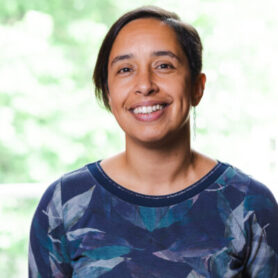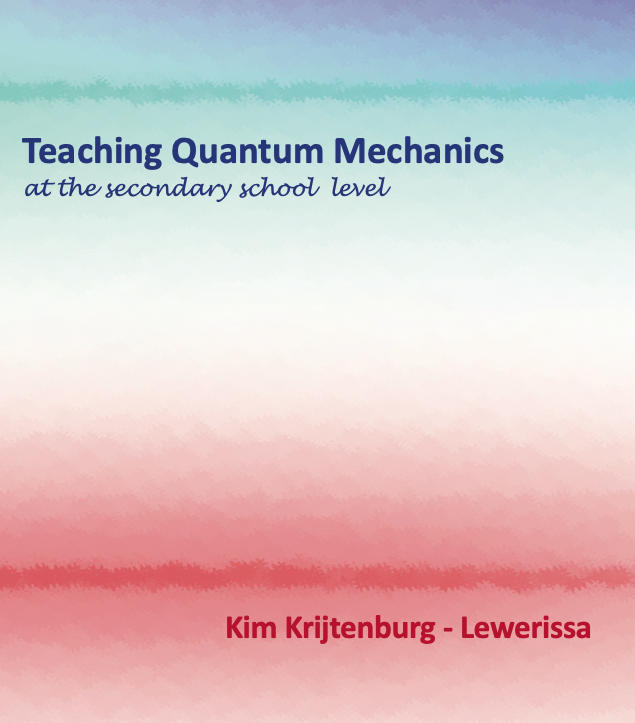Quantum mechanica in het voortgezet onderwijs, hoe realiseer je meer begrip?
 Kim Krijtenburg-Lewerissa Kim Krijtenburg-Lewerissa |
 |
Teaching Quantum Mechanics at the secondary school level. University of Twente, Enschede, 2020. |
Insights into teaching quantum mechanics in secondary and lower undergraduate education
This study presents a review of the current state of research on teaching quantum mechanics in secondary and lower undergraduate education. A conceptual approach to quantum mechanics is being implemented in more and more introductory physics courses around the world. Because of the differences between the conceptual nature of quantum mechanics and classical physics, research on misconceptions, testing, and teaching strategies for introductory quantum mechanics is needed. For this review, 74 articles were selected and analyzed for the misconceptions, research tools, teaching strategies, and multimedia applications investigated. Outcomes were categorized according to their contribution to the various subtopics of quantum mechanics. Analysis shows that students have difficulty relating quantum physics to physical reality. It also shows that the teaching of complex quantum behavior, such as time dependence, superposition, and the measurement problem, has barely been investigated for the secondary and lower undergraduate level. At the secondary school level, this article shows a need to investigate student difficulties concerning wave functions and potential wells. Investigation of research tools shows the necessity for the development of assessment tools for secondary and lower undergraduate education, which cover all major topics and are suitable for statistical analysis. Furthermore, this article shows the existence of very diverse ideas concerning teaching strategies for quantum mechanics and a lack of research into which strategies promote understanding. This article underlines the need for more empirical research into student difficulties, teaching strategies, activities, and research tools intended for a conceptual approach for quantum mechanics.
Krijtenburg-Lewerissa, K., Pol, H. J., Brinkman, A., & Van Joolingen, W. R. (2017). Insights into teaching quantum mechanics in secondary and lower undergraduate education. Physical review physics education research, 13(1), 010109. http://doi.org/10.1103/PhysRevPhysEducRes.13.010109
Key topics for quantum mechanics at secondary schools: a Delphi study into expert opinions
This article describes a Delphi study aiming to investigate which quantum mechanics topics experts consider to be important to teach at the secondary level, and what arguments these experts give. A series of three questionnaires was administered to experts in the fields of quantum physics, mathematics, chemistry and biophysics (n=17, 12, 11 for the first, second, and third questionnaires, respectively; the number of participants changed due to attrition). Several experts from this group (n = 9) were also interviewed. Results show that there is consensus on the topics considered to be important, i.e. duality, wave functions and atoms. Experts mainly based their topic ranking on relations between concepts, and on what quantum mechanics topics they consider to be fundamental. The topics that were considered less important were often described as too difficult or too complex.
Krijtenburg-Lewerissa, K., Pol, H. J., Brinkman, A., & Van Joolingen, W. R. (2019). Key topics for quantum mechanics at secondary schools: a Delphi study into expert opinions. International journal of science education, 41(3), 349-366. https://doi.org/10.1080/09500693.2018.1550273
Secondary school students’ misunderstandings of potential wells and tunneling
In order to investigate students’ misunderstandings of potential wells and tunneling, a conceptual knowledge test was administered to Dutch secondary school students after they were taught about quantum mechanics. A frequency analysis of responses to the multiple choice questions (n ¼ 98) and coding of the responses to the open-ended questions and explanations (n ¼ 13) shows that Dutch secondary school students experience difficulties similar to those reported for undergraduate students. The students’ underlying difficulties were analyzed using a typology of learning impediments. Results of this analysis show that students have difficulty connecting knowledge of potential wells and tunneling to their prior knowledge. Students mainly have creative and epistemological learning impediments, which cause eight incorrect synthetic models.
Krijtenburg-Lewerissa, K., Pol, H. J., Brinkman, A., & Van Joolingen, W. R. (2020). Secondary school students’ misunderstandings of potential wells and tunneling. Physical Review Physics Education Research, 16(1), 010132. https://doi.org/10.1103/PhysRevPhysEducRes.16.010132
Prior knowledge of potential energy and the understanding of quantum mechanics
Quantum mechanics (QM) has become part of many secondary school curricula. These curricula often do not include the mathematical tools for a formal, mathematical introduction of QM. QM therefore needs to be taught at a more conceptual level, but making secondary school students understand counterintuitive QM concepts without introducing mathematical formalism is a challenge. In order to accept QM, students not only have to see the need of it, but also have to see that QM is understandable and logical. Dutch secondary school students are familiar with potential energy (PE) in the context of gravitational and elastic energy. Therefore, the introduction of QM by using the potential wells and tunneling with emphasis on students’ prior knowledge of PE could be a way to make QM more understandable and logical. To explore this, we investigated the relation between the understanding of energy diagrams and the understanding of the potential well and tunneling. A module was created to promote students’ understanding of PE in classical context. Then, a quasi-experimental intervention was used, in which the experimental group received additional lessons using the module on classical energy diagrams before being taught QM. Two tests were developed in order to determine students’ understanding of PE and QM. The results of the tests showed that the experimental group not only had better understanding of PE diagrams, but also of QM even before they were being taught QM. Analysis of the tests also showed that there was a significant correlation between the understanding of PE diagrams and the understanding of QM. Therefore, the results of this study indicate that emphasis on PE can be used to reduce the gap between students’ prior knowledge and QM.
Krijtenburg-Lewerissa, K., Pol, H., Brinkman, A., & Van Joolingen, W. (2021). Prior knowledge of potential energy and the understanding of quantum mechanics. Physics Education, 57(2), 025012. https://doi.org/10.1088/1361-6552/ac3d3a
Prior Knowledge of Potential Energy
The teaching materials evaluated in study 4 can be found here:
- Module on Potential Energy (Dutch) (English)
- Worksheets Module on Potential Energy (Dutch)
- Answers part 1 (Dutch)
- Worksheets Potential Wells (Dutch)
- Worksheets Tunneling (Dutch)
- Answers part 2 (Dutch)
Inquiry Learning Space on Tunneling
In collaboration with Luiza Vilarta Rodriguez and Jan van der Veen I developed an online inquiry learning space about tunneling for secondary school students. A description of the materials was published in NVOX:
Vilarta Rodriguez, L., van den Berg, E., de Jong, T., Krijtenburg – Lewerissa, K., & van der Veen, J. (2024). Quantum tunneling: Een tweetal digitale lessen. NVOX, 2024(5). https://www.nvon.nl/nvox/nvox-2024-5-geheel
The inquiry learning space can be found here:


